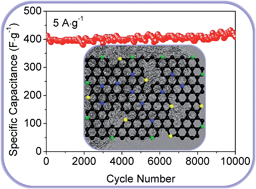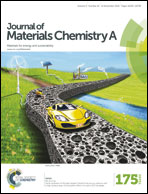Nitrogen-doped carbon nets with micro/mesoporous structures as electrodes for high-performance supercapacitors†
Abstract
Carbon-based supercapacitors with high power densities suffer from relatively low energy densities. Nitrogen-doped hierarchical micro/mesoporous carbon nets were successfully fabricated via supramolecular assemblies of block copolymer P123 with the assistance of dicyandiamide and TiO2. The as-obtained carbon nets have a large specific surface area of approximately 2144 m2 g−1, high-level nitrogen doping with a nitrogen content of approximately 8.25 wt%, and a hierarchical porous network composed of micropores and mesopores. The hierarchical porous carbon nets exhibit high specific capacitance (537.3 F g−1 and 306.3 F cm−3 at 0.5 A g−1 in a 0.5 M H2SO4 electrolyte) and outstanding cycling stability (approximately 98.8% of their capacitance was retained after 10 000 cycles at 5 A g−1). The symmetric supercapacitor based on these hierarchical porous carbon nets could deliver a maximum energy density up to 22.6 W h kg−1. The improved electrochemical performance of these carbon nets stems from both high surface area and the hierarchical micro/mesoporous structure, which provides an accessible pathway for electrolyte transport. In addition, the incorporation of nitrogen dopants into the carbon was intended to further enhance the capacitance performance. This research provides a facile and effective method to obtain micro/mesoporous carbon with a high surface area and doping level of heteroatoms for high-performance supercapacitors.


 Please wait while we load your content...
Please wait while we load your content...